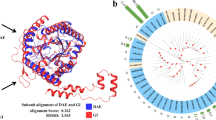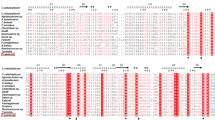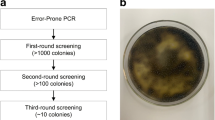Abstract
d-allulose, the epimer at C-3 position of d-fructose, is a low-calorie functional rare sugar, which is regarded as one of the most potential sweeteners. At present, the main production method of d-allulose is epimerization of d-fructose by d-allulose 3-epimerase (DAE). However, industrial applications of DAE are still limited by its poor thermostability. Herein, directed evolution was applied to improve the thermostability of DAE from Clostridium cellulolyticum H10 (CcDAE). Two optimal mutants D281G and C289R, exhibiting 13.80-fold and 13.88-fold t1/2 values as that of wild type at 65 ℃, respectively, were obtained. To further enhance the thermostability, the triple mutant A107P/D281G/C289R was constructed after combination of mutants D281G, C289R, and previously identified thermostability-enhanced mutant A107P. The Tm and optimal temperature of triple mutant were increased by 14.39 ℃ and 5 ℃, respectively, compared to the wild type, meanwhile, the half-life of triple mutant was 58.85-fold as that of wild type at 65 ℃. Furthermore, the conversion rate of triple mutant was increased from 24.76% of wild type to 27.53% using 300 g/L d-fructose as substrate at 70 ℃. The effectiveness of directed evolution was verified and the triple mutant with enhanced thermostability had great application value in the large-scale production of d-allulose.





Similar content being viewed by others
References
Chen J, Chen D, Ke M, Ye S, Wang X, Zhang W, Mu W. Characterization of a recombinant d-allulose 3-epimerase from Thermoclostridium caenicola with potential application in d-allulose production. Mol Biotechnol. 2021;63(6):534–43. https://doi.org/10.1007/s12033-021-00320-z.
Nagata Y, Kanasaki A, Tamaru S, Tanaka K. d-psicose, an epimer of d-fructose, favorably alters lipid metabolism in Sprague-Dawley rats. J Agric Food Chem. 2015;63(12):3168–76. https://doi.org/10.1021/jf502535p.
Chen J, Huang W, Zhang T, Lu M, Jiang B. Anti-obesity potential of rare sugar d-psicose by regulating lipid metabolism in rats. Food Funct. 2019;10(5):2417–25. https://doi.org/10.1039/c8fo01089g.
Wang Y. Molecular modification, expression optimization and stability study on d-psicose. 2021. Jiangnan University
Zhang W, Yu S, Zhang T, Jiang B, Mu W. Recent advances in d-allulose: Physiological functionalities, applications, and biological production. Trends Food Sci Technol. 2016;54:127–37. https://doi.org/10.1016/j.tifs.2016.06.004.
Kim H, Hyun E, Kim Y, Lee Y, Oh D. Characterization of an Agrobacterium tumefaciens d-psicose 3-epimerase that converts d-fructose to d-psicose. Appl Environ Microbiol. 2006;72(2):981–5. https://doi.org/10.1128/AEM.72.2.981-985.2006.
Zhang W, Zhang Y, Huang J, Chen Z, Zhang T, Guang C, Mu W. Thermostability improvement of the d-allulose 3-epimerase from Dorea sp. CAG317 by site-directed mutagenesis at the interface regions. J Agric Food Chem. 2018;66(22):5593–5601. https://doi.org/10.1021/acs.jafc.8b01200
Su L, Sun F, Liu Z, Zhang K, Wu J. Highly efficient production of Clostridium cellulolyticum H10 d-psicose 3-epimerase in Bacillus subtilis and use of these cells to produce d-psicose. Microb Cell Fact. 2018;17(1):188. https://doi.org/10.1186/s12934-018-1037-1.
Li C, Lin J, Guo Q, Zhang C, Du K, Lin H, Lin J. d-psicose 3-epimerase secretory overexpression, immobilization, and d-psicose biotransformation, separation and crystallization. J Chem Technol Biotechnol. 2018;93(2):350–7. https://doi.org/10.1002/jctb.5360.
Chen J, Chen D, Chen Q, Xu W, Zhang W, Mu W. Computer-aided targeted mutagenesis of Thermoclostridium caenicola d-allulose 3-epimerase for improved thermostability. J Agric Food Chem. 2022;70(6):1943–51. https://doi.org/10.1021/acs.jafc.1c07256.
Zhu Z, Li L, Zhang W, Li C, Mao S, Lu F, Qin HM. Improving the enzyme property of d-allulose 3-epimerase from a thermophilic organism of Halanaerobium congolense through rational design. Enzyme Microb Technol. 2021;149: 109850. https://doi.org/10.1016/j.enzmictec.2021.109850.
Zhao J, Chen J, Wang H, Guo Y, Li K, Liu J. Enhanced thermostability of d-psicose 3-epimerase from Clostridium bolteae through rational design and engineering of new disulfide bridges. Int J Mol Sci. 2021;22(18):10007. https://doi.org/10.3390/ijms221810007.
Zhang W, Jia M, Yu S, Zhang T, Zhou L, Jiang B, Mu W. Improving the thermostability and catalytic efficiency of the d-psicose 3-epimerase from Clostridium bolteae ATCC BAA-613 using site-directed mutagenesis. J Agric Food Chem. 2016;64(17):3386–93. https://doi.org/10.1021/acs.jafc.6b01058.
Mao S, Cheng X, Zhu Z, Chen Y, Li C, Zhu M, Liu X, Lu F, Qin H. Engineering a thermostable version of d-allulose 3-epimerase from Rhodopirellula baltica via site-directed mutagenesis based on B-factors analysis. Enzyme Microb Technol. 2020;132: 109441. https://doi.org/10.1016/j.enzmictec.2019.109441.
Choi J, Ju Y, Yeom S, Oh D. Improvement in the thermostability of d-psicose 3-epimerase from Agrobacterium tumefaciens by random and site-directed mutagenesis. Appl Environ Microbiol. 2011;77(20):7316–20. https://doi.org/10.1128/AEM.05566-11.
Bosshart A, Hee C, Bechtold M, Schirmer T, Panke S. Directed divergent evolution of a thermostable d-tagatose epimerase towards improved activity for two hexose substrates. ChemBioChem. 2015;16(4):592–601. https://doi.org/10.1002/cbic.201402620.
Li C, Zhang W, Wei C, Gao X, Mao S, Lu F, Qin HM. Continuous spectrophotometric assay for high-throughput screening of predominant d-Allulose 3-epimerases. J Agric Food Chem. 2021;69(39):11637–45. https://doi.org/10.1021/acs.jafc.1c04716.
Armetta J, Berthome R, Cros A, Pophillat C, Colombo B, Pandi A, Grigoras I. Biosensor-based enzyme engineering approach applied to psicose biosynthesis. Synth Biol (Oxf). 2019;4(1):ysz028. http://doi.org/https://doi.org/10.1093/synbio/ysz028
Krauss U, Jaeger KE, Eggert T. Rapid sequence scanning mutagenesis using in silico oligo design and the Megaprimer PCR of whole plasmid method (MegaWHOP). Methods Mol Biol. 2010;634:127–35. https://doi.org/10.1007/978-1-60761-652-8_9.
Farnoosh G, Khajeh K, Mohammadi M, Hassanpour K, Latifi AM, Aghamollaei H. Catalytic and structural effects of flexible loop deletion in organophosphorus hydrolase enzyme: A thermostability improvement mechanism. Journal of Biosciences. 2020;45(1). https://doi.org/10.1007/s12038-020-00026-5
Schwede T, Kopp J, Guex N, Peitsch M. SWISS-MODEL: An automated protein homology-modeling server. Nucleic Acids Res. 2003;31(13):3381–5. https://doi.org/10.1093/nar/gkg520.
Kumar S, Dangi A, Shukla P, Baishya D, Khare S. Thermozymes: adaptive strategies and tools for their biotechnological applications. Bioresour Technol. 2019;278:372–82. https://doi.org/10.1016/j.biortech.2019.01.088.
Niu C, Zhu L, Zhu P, Li Q. Lysine-based site-directed mutagenesis increased rigid beta-sheet structure and thermostability of mesophilic 1,3–1,4-beta-glucanase. J Agric Food Chem. 2015;63(21):5249–56. https://doi.org/10.1021/acs.jafc.5b00480.
Sokalingam S, Raghunathan G, Soundrarajan N, Lee S. A study on the effect of surface lysine to arginine mutagenesis on protein stability and structure using green fluorescent protein. PLoS ONE. 2012;7(7): e40410. https://doi.org/10.1371/journal.pone.0040410.
Xu Z, Cen Y, Zou S, Xue Y, Zheng Y. Recent advances in the improvement of enzyme thermostability by structure modification. Crit Rev Biotechnol. 2020;40(1):83–98. https://doi.org/10.1080/07388551.2019.1682963.
Chen C, Su L, Xu F, Xia Y, Wu J. Improved thermostability of maltooligosyltrehalose synthase from Arthrobacter ramosus by directed evolution and site-directed mutagenesis. J Agric Food Chem. 2019;67(19):5587–95. https://doi.org/10.1021/acs.jafc.9b01123.
Tu T, Luo H, Meng K, Cheng Y, Ma R, Shi P, Huang H, Bai Y, Wang Y, Zhang L, Yao B. Improvement in thermostability of an Achaetomium sp. strain Xz8 endopolygalacturonase via the optimization of charge-charge interactions. Appl Environ Microbiol. 2015;81(19):6938–44. https://doi.org/10.1128/AEM.01363-15
Acknowledgements
The authors are grateful for the financial support from the National Natural Science Foundation of China (NSFC) (32101884) and Natural Science Foundation of Jiangsu Province (BK20190586).
Author information
Authors and Affiliations
Contributions
SL Conceptualization, Methodology, Data curation, Visualization, Writing-original draft; YW Methodology, Visualization; DK Methodology; JW Conceptualization, Supervision, Writing-Review & Editing; ZL Conceptualization, Funding acquisition, Supervision, Writing-Review & Editing.
Corresponding authors
Ethics declarations
Conflict of interest
Conflict of interest the authors declare that they have no conflicts of interest.
Supplementary Information
Supplementary Information: SDS-PAGE of CcDAE and mutants, the probability distribution of distance between Arg289 in chain A and Glu275 and Arg 274 in chain B.
Below is the link to the electronic supplementary material.
Rights and permissions
About this article
Cite this article
Liu, S., Wang, Y., Kong, D. et al. Enhancing the thermostability of d-allulose 3-epimerase from Clostridium cellulolyticum H10 via directed evolution. Syst Microbiol and Biomanuf 2, 685–694 (2022). https://doi.org/10.1007/s43393-022-00096-6
Received:
Revised:
Accepted:
Published:
Issue Date:
DOI: https://doi.org/10.1007/s43393-022-00096-6




